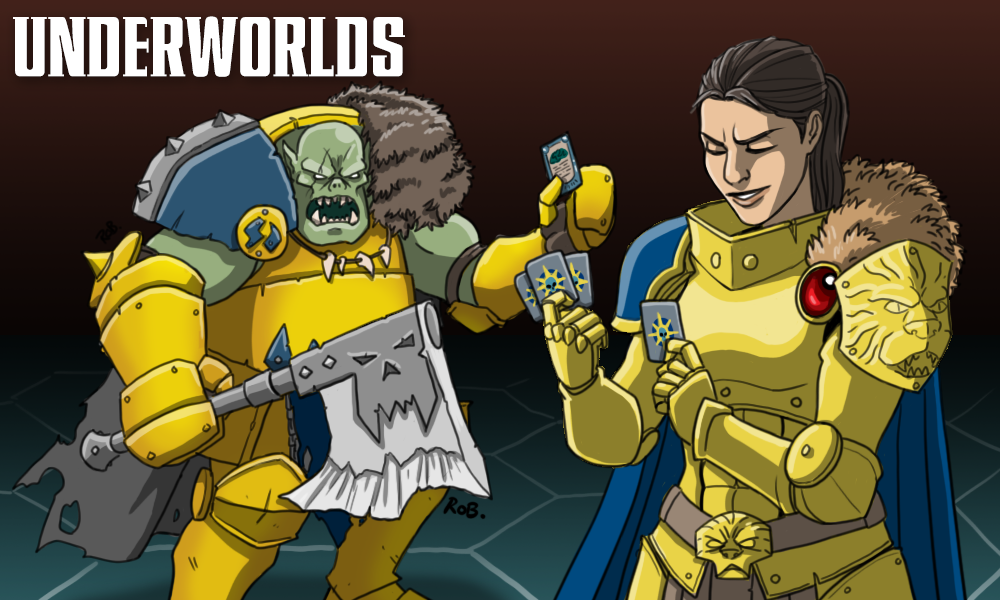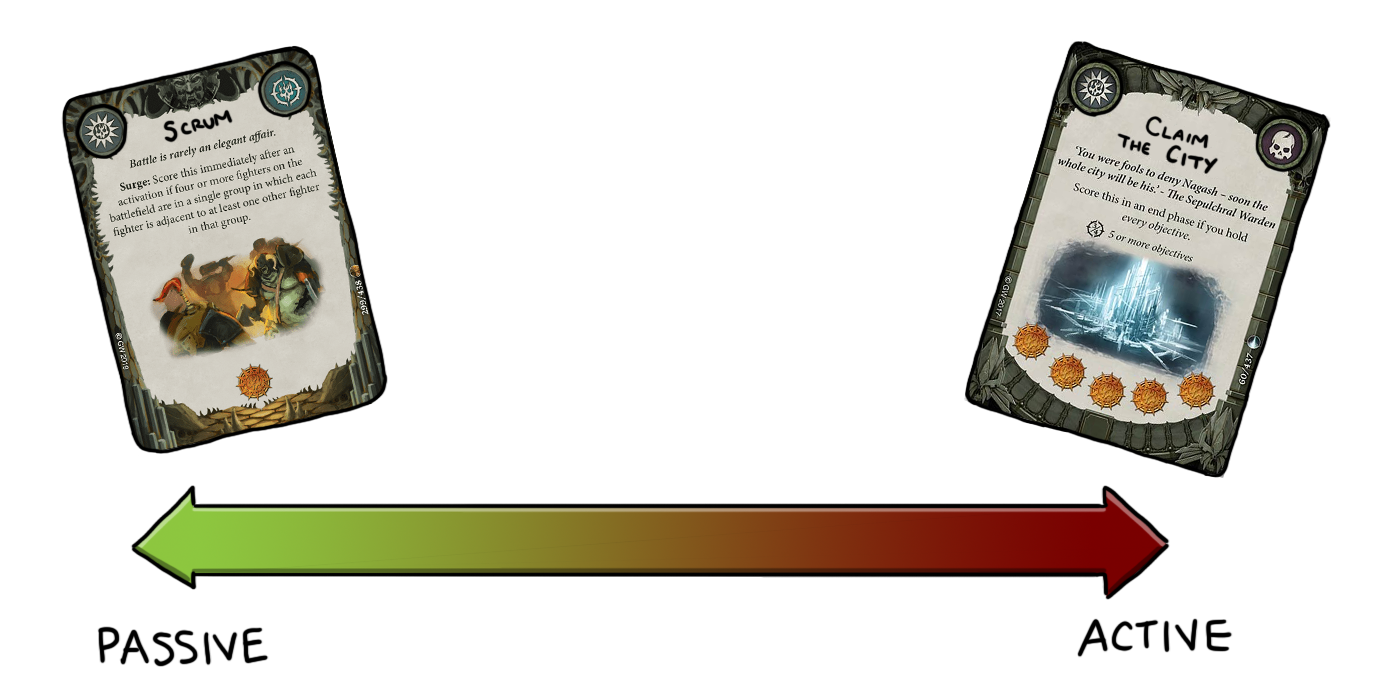Glory Hunting is a semi-regular series aimed at helping you play Warhammer Underworlds! Check out our previous coverage here.
The Grymwatch are a brutal band of feral ghouls inhabiting Beastgrave in search of honor food, glory food, and redemption meat. They’re members of the Flesh Eater Court faction, whose backstory is one of my favorites in all of Age of Sigmar. The Court sees itself dressed in regalia, arrayed on the battlefield in knightly order. They are virtuous and bold. Heroic even. In reality, they’ve been cursed to roam the land as horrifying monsters who feast on those they believe they’re saving. I love it.
In Underworlds their release precipitated a flurry of online chatter. Cries of “Broken!” rang out over the land, drowned out only by yells of “Power Creep!”. While they haven’t quite cracked the game open like the pulpy skull of treasure hunting duardin, they are indeed quite powerful. Michael of Steel City Underworlds piloted them to victory at the Warhammer World October Grand Clash, and I recently won a local store tournament with a similar deck (I also took Best Painted!). While the fighters themselves are good, what really pushes these creatures over the edge is their ability to leverage passive glory scoring. The bulk of this article will talk about this concept in Underworlds, but before I get into it it’s worth pointing out some of the strengths of the warband and key cards they bring to the table.

Like the first two warbands released in the Beastgrave Core Set, the Grymwatch fighters all have a weak Defense characteristic: 1 dodge. That’s about their only weakness, however. The warband features 4 fighters with 3 or more health and all 7 boast an impressive 4 move. The Harriers – vampiric bats seen as hunting dogs by ole Duke – have 5 right off the bat! The 3 Crypt Ghouls don’t have impressive stats, but the Duke’s Ghoul Call ability can bring them back deep behind enemy lines. Gristlewel’s greatsword (bone club) even does 3 damage without inspiring! No one except Mollog is truly safe from this monster.
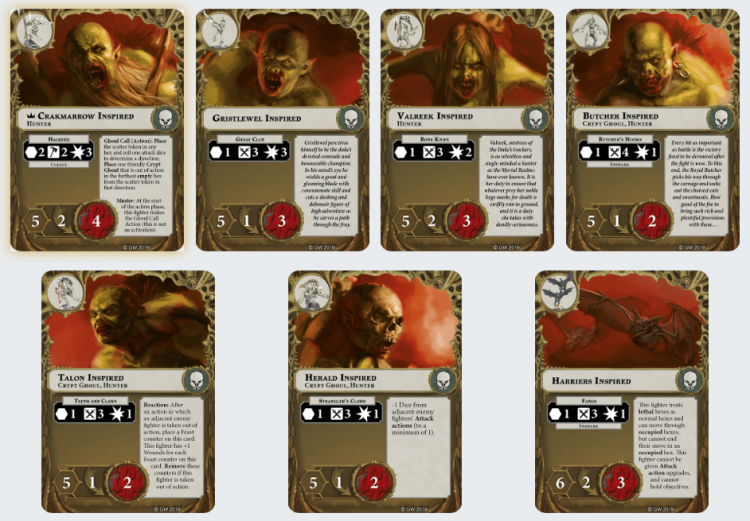
Inspired, this warband becomes a nightmare. All of them get even faster, Duke gains cleave and an extra point of damage on a fairly accurate attack, and everyone else gains accuracy and bonus abilities. Facing off against inspired Grymwatch is a terrifying proposition. They definitely benefit from an Objective Heavy Glory deck; your opponent will struggle to keep you off of objectives and keep you uninspired at the same time.
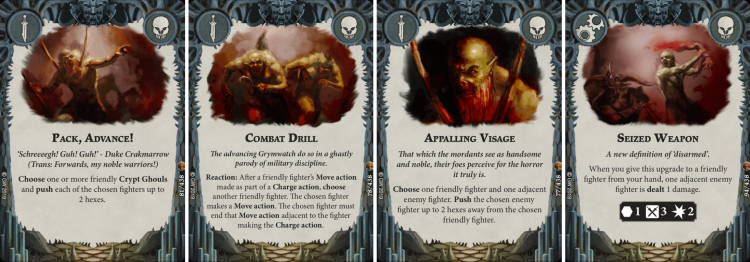
This is but a selection of the various faction cards included with this warband. It’s not an exaggeration to say that you could simply play a game using 100% faction cards and do just fine in a casual setting. There is lots of movement and bonus damage in this warband, helping you capitalize on their innate speed and aggression. We’re going to go a step further however, and show you how you can leverage their abilities to rack up a massive pile of glory and bring these monsters to victory. If you want to reference my deck now, you can find it here.
Not All Glory is Earned Equally
At the end of the day, it doesn’t matter how great you roll, how quick you move, or how nice your paint job is (I took Best Painted at a recent tourney) if you don’t score any Glory. Warhammer Underworlds makes it possible to win even if you get completely wiped out so long as your pile of little gold tokens is larger than your opponents. This means that identifying how your fighters can score efficiently is paramount. In our Deck Building 101 and 201 articles I talked about building decks with a lot of synergies; ideally you want to score many points for doing few things. Now I want to expand on that by talking about Passive and Active glory.
Active glory is easy to understand and recognize, and makes up the majority of the Glory available to you. Active glory is glory that you must exert effort and activations to score. You must actively pursue it. The glory you get from eliminating a fighter is a good example. Most of the time you’ll have to maneuver into position with 1 or more fighters and then spend 1 or more actions and cards to eliminate the enemy. For that effort, you get a glory.

Finders of the Way – new in the Beastgrave Gift Pack – is another example of Active Glory. For starters it requires meeting 2 objectives, which means you’ll have double the responsibilities. The 2nd condition requires you to play Cursed Key upgrades onto multiple fighters. This requires a lot of work. First you’ll have to ensure 3 fighters survive. Then you’ll have to play specific upgrades to them which requires having scored at least 3 glory and having drawn into the keys which may require additional effort. Passive vs Active is a sliding scale, however, not an inherent trait and will change based on the situation. If you build a deck where you already plan to equip Cursed Keys to your fighters then you can shift this card in the passive direction. That’s why identifying synergies like I mentioned in the Deck Building articles is so important.
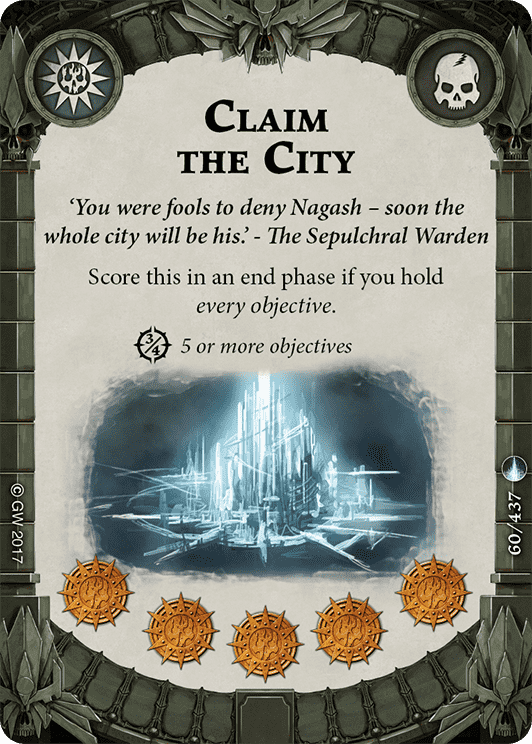
The warband you’ve chosen is also an important consideration in determining whether the objective you want to play is Passive or Active. Claim the City belongs to the Sepulchral Guard, a warband of skeleton fighters. This is an extremely active card for this particular warband. Your best case scenario is to have 3 Objective tokens on your side of the board, meaning you’ve got to stand on and hold 2 objectives in your opponent’s territory. While cards exist to remove objectives from the board, the Guard lack a spellcaster and thus only have access to 2 of them. Being skeletons, they aren’t exactly defensive stalwarts. This all adds up to a card that requires a lot of work to score. Sure it’s got 5 glory printed on it but it’s worth exactly zero if you can’t score it.
The less work you have to put in to score an Objective in Underworlds, the better. We’re working with a limited set of 12 activations and a small pool of cards to get things done so we should always be looking for ways to score as many points as possible with as little action as possible. I think we can all agree that getting something for nothing is great. If your boss walked in tomorrow and said “Hey pal, hows about a cash bonus. Just go refill your water bottle sometime today.” you’d love it. Free money baby (you are staying hydrated right?).
Passive glory is glory scored for doing nothing, or at least for doing something that you were planning to do anyway. Cover Ground scores if you make a Move of 6 or more. There are no restrictions on that move other than the length which means you can score this on your way to doing whatever it is you need that fighter to do. Need it to stand on a far away objective? You can score Cover Ground on the way over. Need it to charge into combat? You can score Cover Ground as you start pummeling your opponent.
Of course, most fighters have move values between 2-4 meaning the glory isn’t completely free. While boosting movement is generally a good thing, getting one of Thundrik’s Profiteers to Move 6 spaces will require way more work than getting Skritch to move 6 spaces. Cover Ground is more Active for Thundrik, but fairly Passive for Skritch. And if you had a native move value of 6? The most passive. Know any fighters who fit that bill?
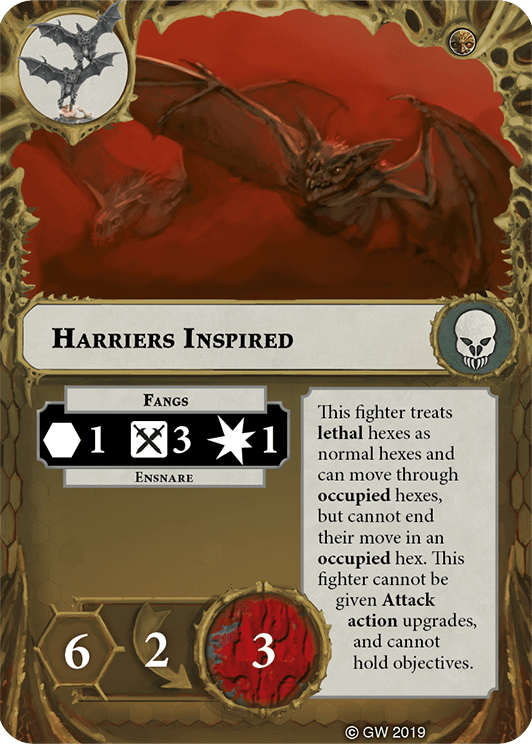
Aha. Once inspired, Duke’s Harriers movement jumps to an absurd value of 6 making them capable of scoring Cover Ground without you having to exert any effort on making them faster. As soon as these fighters flip to their gold side, you’re an easy activation away from scoring Glory.
Now, what if you could score glory for doing nothing. That’d be ideal right? As it turns out, that card exists in Warhammer Underworlds.

Look at that beauty. All it takes to score this card is a single group of 4 fighters. Zarbag’s Gitz can deploy in such a way as to meet this requirement on every single board in the game. It literally does not get more passive than deploying your fighters and scoring an objective at the end of your opponent’s turn, before you even play a single card. Like Cover Ground, this card is harder to score for some warbands though it’s worth noting that if you have it in your hand you can score it at the same time as that Zarbag opponent.
Passive Synergy
So now let’s talk about how we can combine what we learned in Deck Building 101 and 201 about Objective synergy with the concepts of Passive Glory. The goal should be scoring lots of glory without having to go out of our way to do it, or at least pushing every card we have as far down the Passive scale as we can. Remember, Passive Glory is easy glory and while we may not score any cards that award 5 glory at one time, we should make up for it in consistency. I strongly recommend you open my Grymwatch deck in another tab to follow along with the cards; I packed it with Passive glory and used it to win a small local tourney. I even took best painted!
Using the power of MS Paint, I’m going to illustrate a situation that’s relatively easy to concoct early in the game. I’ll use the Penitent’s Throne for the picture, but you can do this on the Cursed Oubliette, the Mirror Well, the Ruptured Seal, and a few others. In the image the Red numbers 1-3 represent three objective tokens and the white arrows are moves made with Pack Advance. It’s pictured above, but its effect allows you to push all three Crypt Ghouls 2 hexes. Assume all of our fighters are on the starting hexes, with the Crypt Ghouls standing at the origin of the white arrows.
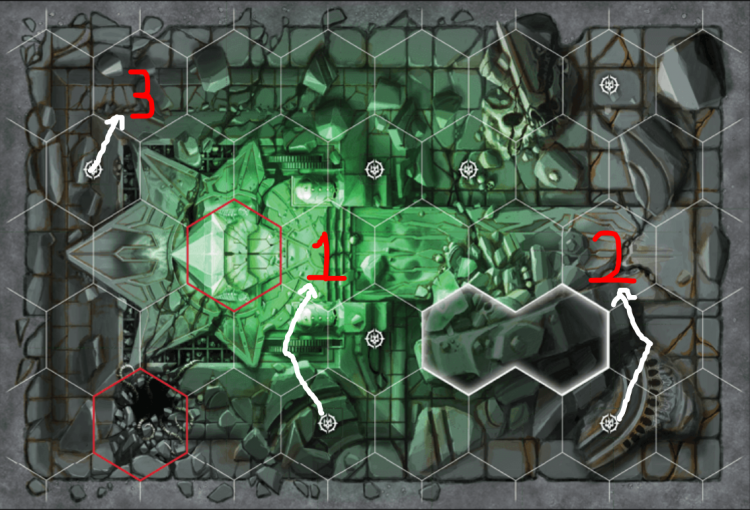
In general, this is a decent play at any point in the first round. We’ve pushed our Ghouls up, enabling them to threaten our opponent directly. We hold 3 objectives and haven’t spent an activation to do so; in other words we’ve done very little work. And, we can score Scrum at the end of the next activation! If we play Pack Advance! after our opponent’s activation there’s very little they can do to stop us from scoring it after our next activation. To really hammer this home, here’s the specific scenario.
- Opponent activated, and didn’t kill one of our fighters.
- During the power step, we played Pack Advance! and created the scenario above.
- During our activation, we move the fighter in the upper right hand corner onto an objective in enemy territory.
At this point we can score Scrum, In the Name of the King, and Swift Capture with a 61% chance of having at least one in our opening hand! We’ve got a really good chance of being able to score Shifting Madness and we’re set up to score it next round if we can’t. We’re also threatening Conquering Heroes and Supremacy at the end of the round. Scoring any of those lets us score Opening Gambit, and we’re almost certain to score Solid Gains. If we can kill at least 1 enemy – perhaps in Step 3 above by charging – then we can also score Path to Victory. Finally, if our move in Step 3 was through a lethal hex then we can also score Calculated Risk. That is 10/12 of our Glory Deck ready to score with only 1 card played and 1 activation. Let me repeat that.
With only 1 card and 1 activation we can score up to FIVE SIXTHS of our deck.
It’s worth noting that with the exception of Path to Victory (requires a kill) all that glory can be scored by simply doing nothing once you’re in position. There is an absurd amount of passive glory potential made all the more potent by the overlapping synergies of the objectives in that deck. Now, of course things can go wrong. Your opponent can push you off objectives or kill you before you get to the end phase. Objectives can be moved or destroyed. Your power deck and objective deck may not cooperate. Nothing is guaranteed in Underworlds.
That said, you don’t have to do much to threaten a lot. Even without Pack Advance! in your hand you can move onto 3 Objectives the old fashioned way, or use the other pushes in the deck. Multiple times in this tournament I scored all 12 of my objective cards, and in the others I was only short a couple. Even the games I lost were close, and my opponent had to really push to beat me. It’s difficult to deal with an deck that feels like it can almost automatically score 12-14 glory before you count kills. One of my opponents commented that it felt like no matter what he did he simply couldn’t stop me from scoring out my objective cards. That didn’t happen because I’m some Underworlds super-player. That’s the power of Passive Glory.
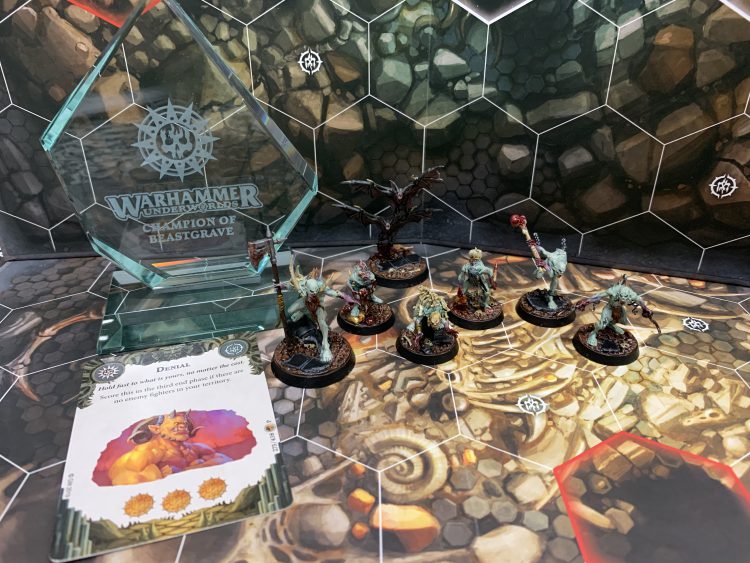
More to Come
We’ve been behind in our Underworlds coverage recently, but you can rest assured we’ll have more soon. In the meantime, if you have any questions, notes, or feedback, shoot us a message in the comments below, or email us at contact@goonhammer.com.
